|
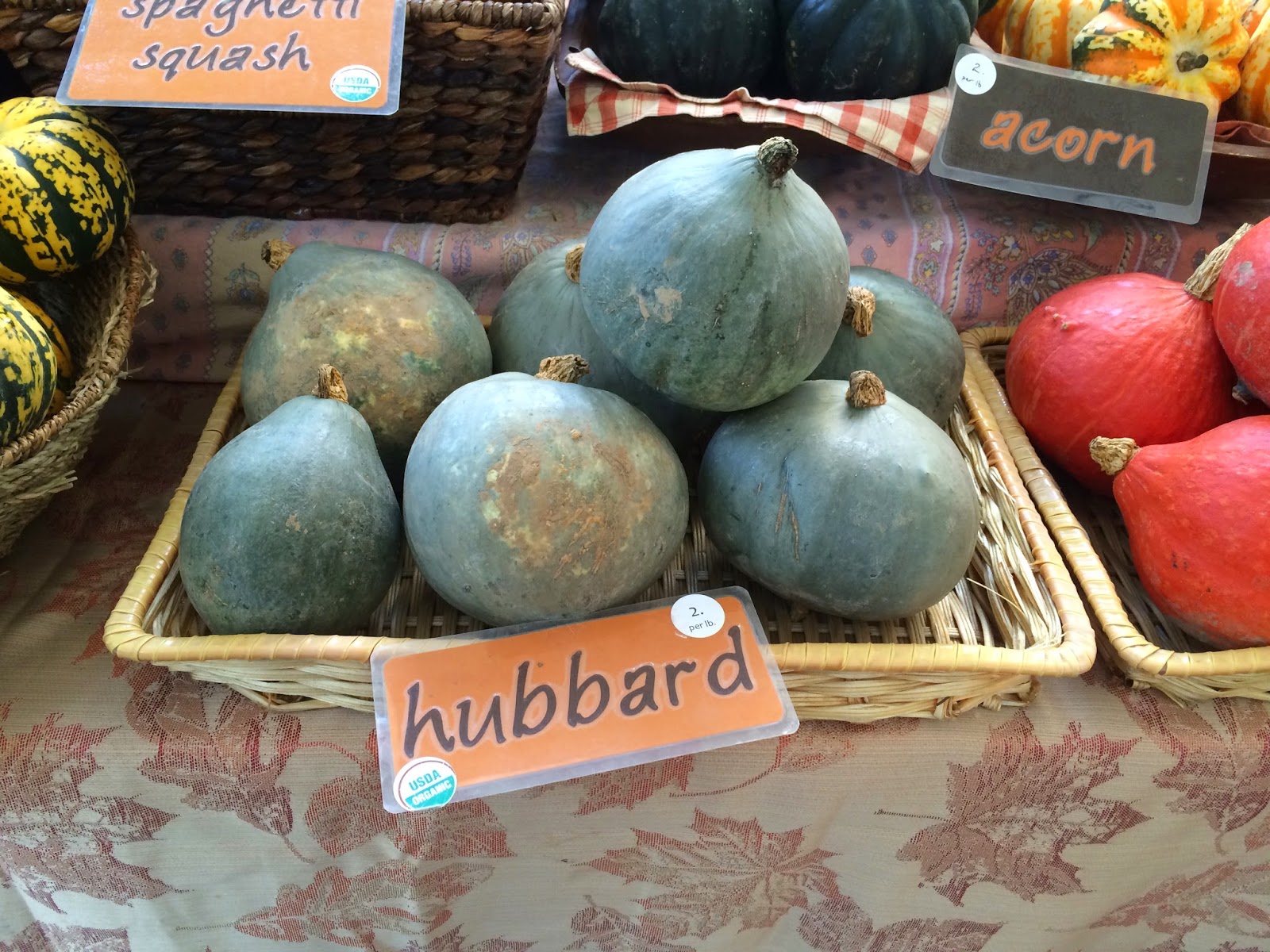
Developed in 1953 by the University of New Hampshire, this hubbard shaped fruit has fine-grained, yellow-flesh. While sweet and of excellent culinary quality, it's shape and color is very pleasing to the eye. Fruits are 2-3 kgs.
Hubbards are all full-flavoured, sweet, usually moist and ‘buttery’ in texture. Some varieties are a bit drier (e.g. blue/grey hubbard) and some are moister (e.g. green hubbard, and all the orange ones). The original variety of Hubbard squash is native to South America. The Hubbard squash is thought to have been grown in New England since the 1830's and sold commercially since 1909.
Varieties:
Blue Kuri
Native to Japan.
Fruits with light green epidermis are rounded, flattened, and weigh 1 to 1.5 kg. The flesh is thick orange, fine-grained, a little floury and excellent. Also suitable for making jams. Growth: 120-130 days.
Tokyo Blue Squash
Nicknamed aromatherapy chestnut pumpkin for its incredible sweetly scented flesh, this traditional variety was so popular in Tokyo that it is known throughout Japan simply as the Tokyo pumpkin. Originally introduced by a farmer in Tachiwa City, Tokyo, it became a popular market variety thanks to early maturity, attractive blue skin and an exceptionally fine grained, aromatic, bright yellow flesh. Seeds were first made available by Watanbe Seeds of the Miyagi prefecture in 1931, and Tokyo markets were quickly filled with these signature scented squash. The virtues that made this an exemplary market variety of pre WWII Japan, from early maturity to exceptional eating quality, are exactly what makes a fantastic farmers market variety in today’s slow food renaissance. 120 days.
|

Round fruits, noticeably flattened, with many very marked ribs, are gray-green in color. They can exceed 5 kg. The orange flesh is thick and tasty.
Traditional variety from northern Italy, very common in the provinces of Emilia and Mantua,
as it is suitable for tortelli. It has a sweet and firm pulp; it is preserved for a long time in the winter.
Varieties:
Zucca Mantovana
Fancy rare Heirloom variety that is actually found only in the region of Mantua (Italy). Very pretty and decorative. Better durable than the colored turbans; Plant: climbing; Fruit shape: turban-shaped, with a large and broad flower approach, gray monochrome; Fruit size (DxH): 15 x 20 cm; Flesh: almost dark orange, thick, tender and sweet, good quality.
The city of Mantova, in the province of Lombardy in Northern Italy, is a picturesque center of culture and cuisine. The surrounding plains stretching across the Po river valley into Emelia Romagna form much of the northern bread basket of Italy, home to many of the famous Italian cured meats, cheeses like Grana Padano, Gorgonzola, and Parmigiano-Reggiano, and large tracts of vegetable production. Also known locally as “Bishops Hat” and “Berrettina Piacentina” this beautiful slate blue turban-type squash features prominently in a typical dish from the city and its surroundings, Tortelli di zucca: ravioli stuffed with an interesting and delicious flavor mix of winter squash, mustard oil infused preserved quince, and ground up amaretto cookies. If you dare defy tradition however, the squash has a lovely rich flavor and thick texture also suitable for gnocchi, or roasting and adding to autumnal grain and chicory salads. The medium sized 5-8 pound fruits grow on vigorous, sprawling vines. 100 days.
Indomatrone
Indomatrone is an old pumpkin variety (possibly Italian) with a small turban shape and smooth rind ranging from grey to grey-green in colour. The thick, orange flesh is dry, very smooth, sweet with great flavour. This quality flesh would be excellent for baking in scones, cakes and pies. The medium vines produce a good crop of family size fruit ranging from 1kg to 2kg in about 100 days.
|
|
The Blue Ballet Squash is a much smaller version of the Blue Hubbard. The Blue Ballet produces tear drop shaped squashes that can weigh between 1-2.7kg (2½-6 lbs) each. You can expect to get 3-4 squashes per plant. The Blue Ballet plant is considered a semi bush, but can produce vines that are 1.8-3.0m (6-9’) long. Plant height ranges from 30-50 cm (12-20”) tall. This squash is smoothed skinned, blue gray in colour, turning an off yellow when fully mature or aged.
Smaller and more marketable Blue Hubbard average 4–6 lb, two per plant. Smooth blue-gray skin with sweeter orange fiberless flesh.
Hubbards are all full-flavoured, sweet, usually moist and ‘buttery’ in texture. Some varieties are a bit drier (e.g. blue/grey hubbard) and some are moister (e.g. green hubbard, and all the orange ones). The original variety of Hubbard squash is native to South America. The Hubbard squash is thought to have been grown in New England since the 1830's and sold commercially since 1909.
|
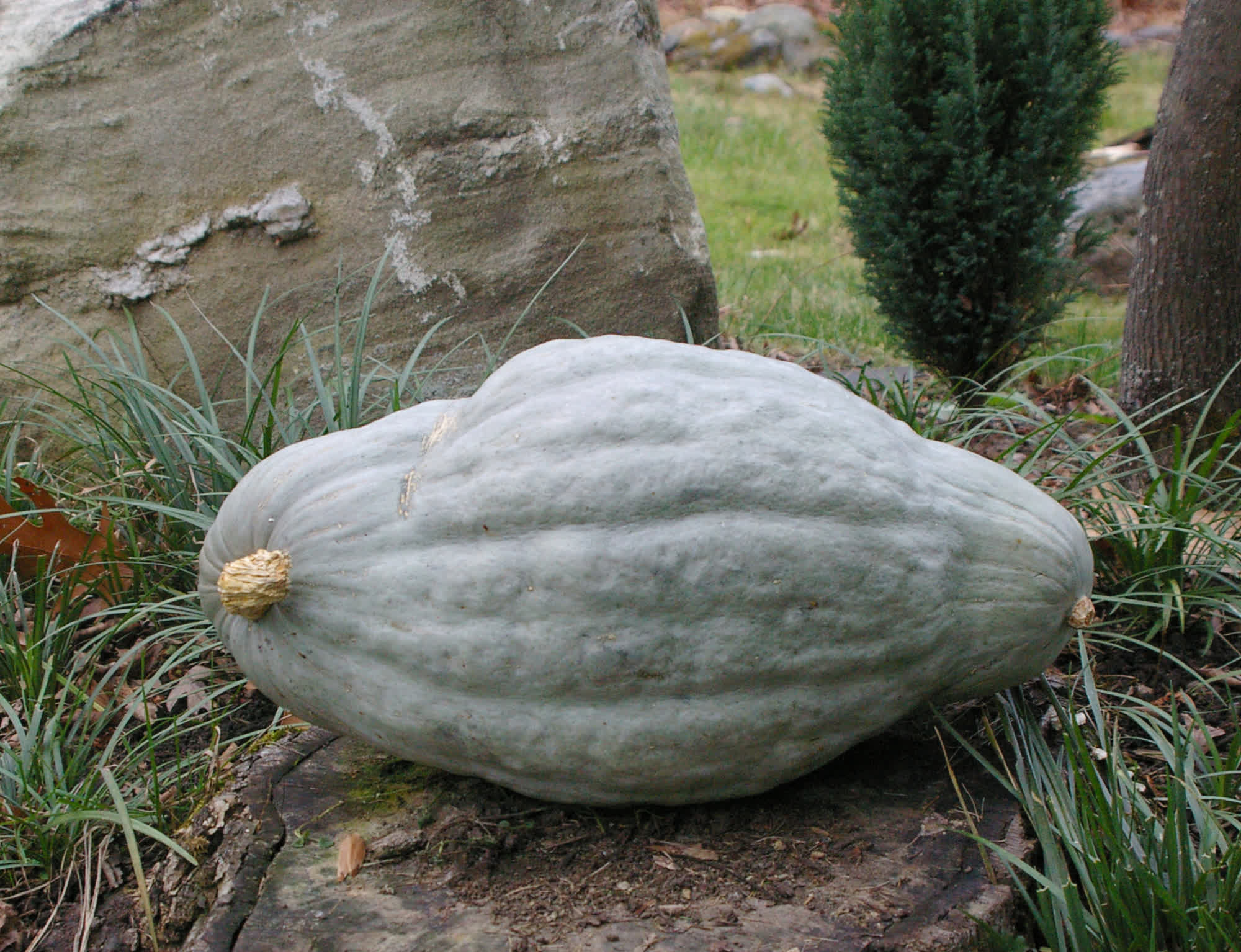
This fruit was carried from the West Indies to New England in 1798 by a sea captain whose name has since been lost. A few gardeners from Massachusetts grew it, saving the seeds from year to year. Around 1842, Mrs. Elizabeth Hubbard noticed its excellent eating qualities and handed it onto her neighbour who was a seedsman. He named it after Mrs. Hubbard and multiplied the seed for sale.
Developed from the original Hubbard squash, Blue Hubbard was introduced by the Gregory Seed Company in 1909. They called it first "Symmes Blue Hubbard", Symmes being the name of a gardener who worked for them. It is a large, 12-15 lb., oval-shaped fruit tapered at both ends with attractive blue-green skin and deep orange, finely textured medium-dry flesh that is very flavourful. Averages 1 - 2 fruits per plant.
Variety runner. Beautiful fruits slightly ribbed, verrucous and oblong, 30 to 35 cm Ų. Very good storage capacity, from several months to more than a year. Growth: 100 days. Each plant produces 2 to 4 fruits.
Hubbards are all full-flavoured, sweet, usually moist and ‘buttery’ in texture. Some varieties are a bit drier (e.g. blue/grey hubbard) and some are moister (e.g. green hubbard, and all the orange ones). The original variety of Hubbard squash is native to South America. The Hubbard squash is thought to have been grown in New England since the 1830's and sold commercially since 1909.
This traditional variety is native to the United States. A less improved version was introduced by James Gregory of Marblehead, Massachusetts, in 1856. This variety has been cultivated in this region since the early 1700s.
Varieties:
Yakima Marblehead Squash
A rare, slate-gray, slightly ribbed, large Hubbard heirloom introduced in 1896 and grown by commercial growers in the Yakima Valley, Washington. Reaching 8-25 pounds, the flesh is golden yellow and is known for its excellent flavor. They easily store around 50 F through the winter, with many storing into the spring. With its combination of sweetness, dryness, and a greater density than other hubbard types, this is truly a fine baking squash. After harvest they should be ripened for 30 days in a cool location. 100 days.
Dineh Hubbard - Native American Variety
Taos Hubbard
Old variety Hubbard type from Taos Pueblo in New Mexico. Plant: vine; Fruits: grey, rounded, elongated; Size (DxL): 22 x 27 cm; Flesh: dark yellow up to orange, thick, sweet, somewhat fibrous; Usage-Recommendation: Soup, Puree, Oven, Steam, Deep-Fry
Storage time: ++++ Weight: 5.5 kg Maturity: 110 days
Navajo Hubbard
Large fruits with green-blue, gray, green, light pink, or orange skin and tasty orange flesh. Shapes are round with pointed ends and occasional elongated fruits. A common Hubbard across the Navajo Nation.
Hopi Pale Grey Squash
A unique and colorful native Hopi Indian variety. The 10 lb round fruits have a very hard lovely pale gray rind, making this a great keeping variety. Orange flesh is both sweet and dry; large vines are quite vigorous. A Southwestern heirloom from the Hopi people that has nearly become extinct in recent years. A favorite for flavor.
Sugar Hubbard
A true Northwest heirloom, developed by the old Gill Brothers Seed Company in Portland, OR. A cross between Sweet Meat and Blue Hubbard, it combines many of the best qualities of both. The skin is a blue-gray, and the flesh is golden and more moist than Sweet Meat. A great keeper, storing up to 1 year. Vigorous 10 foot vines produce 4-5 squash, each weighing 15-20 pounds.
|
|
Very suitable for cooking.
F1 Jarrahdale hybrid with Cinderella type flavour.
An Australian pumpkin type. The Blue Moon pumpkin with its mottled grey rind and orange-yellow flesh has a very sweet and refreshing flavor. They weigh 9 to 11 pounds with a 10 to 12 inch diameter. 100 days.
|
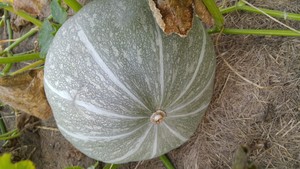
Dark orange flesh eaten raw crunches like a carrot, tastes and smells similar to watermelon rind, after cooking it taste as if you added brown sugar to the squash (but didn't). No other ingredients required. Taste of perfection. Very rare to find seeds. Ukrainian heirloom. Gray-green rind with shallow furrows; orange flesh is dense and excellent for baking.90-100 days. As i was cutting this squash it smelt like cantaloupe/watermelon. Use Chersonskaya instead of pumpkin for your pies. Keeps very well in a cool room, as I have had one in my basement for 2 years! However I don't recommend keeping them that long as the taste fades away as they dry out.
Also known as Pumpkin Lechebnaya - Therapeutic or Curative or Pumpkin Medical, Ukrainian Pumpkin.
Varieties:
Ambar Squash
Compact, semi-bush plants yield deep green fruits. These weigh up to 8 lbs or so. Skin is dark sea-green, rather rough but not exactly warted. The fruits are liberally splashed with lighter, sage-green spangles. The overall effect is pleasing to the eye. Flesh is an intense orange-yellow and very sweet and nutty- tasting. Excellent storage qualities. 90 days.
Zhdana
Also known as Zjdana or Jdana. Earliest Ukrainian maxima squash variety of high quality. Average weight 6-9 kg. / 13-20 lb. Grey-blue skin. Thick red-orange, stringless flesh. Quite moist and surprisingly sweet with very good flavour. For early variety it is quite good raw, backed, steamed. Powdery mildew resistant (on paper). Average keeper.
Slavuta
Another Ukrainian variety. Also known as Zimnyaya Sladkaya. Late, high-yielding variety (120-130 days). Dark grey fruits with small light-grey spots, weight 7-12kg (15-26 lbs.). Thick, dense, orange, sweet flesh with an excellent taste and a high sugar content. Very good resistance to diseases.
Jubilee
Ukrainian variety. So called improved 'Jdana', but latter than Jdana. Quite moist and surprisingly sweet with very good flavour.
Gori Blue Mottled pumpkin
From Gori, Republic of Georgia.
|
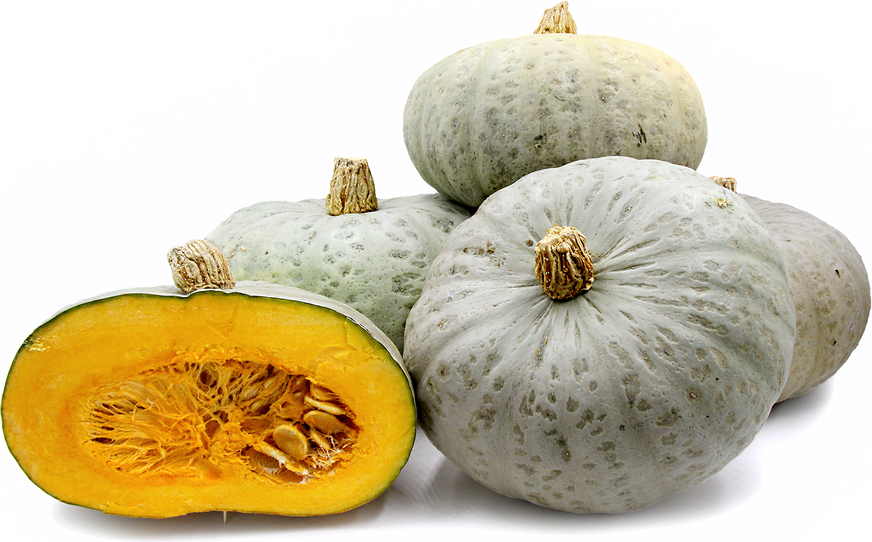
3 to 4 Confection squash grow along short, light green vines. The winter squash has a very pumpkin-like shape, round and slightly flattened with very shallow ribs. Confection squash are small, around 11 to 12 centimeters in height and 16 to 17 centimeters in width. Their size is often compared to that of a kabocha or buttercup variety. Confection squash have smooth, grey skin with the occasional charcoal mottling. The flesh is a vibrant orange color and has a flaky texture. The seed cavity is a moderate size, containing small, flat, pear-shaped seeds. After a period of ‘curing’ in storage post-harvest, the flesh of the Confection squash becomes sweeter and the texture becomes smoother. The sweetness will intensify with prolonged storage.
The Confection squash cultivar requires a “curing” period of 2 to 3 weeks in dry storage after harvest, which allows the sugars to develop within the flesh and improves the texture. Confection squash that are 2 to 5 months post-harvest are said to have the best eating quality. Confection squash is sometimes referred to as Confection Kabocha squash or Kabocha Confection squash, but it is merely a reference to shape versus species.
Geography/History
The Confection squash is a variety bred by Tozer Seeds, a seed company based in the United Kingdom. Confection squash is a hybrid of a well-known British variety, the Crown Prince. The tender Confection squash vine requires more maintenance than the average squash or pumpkin variety, so its availability is limited to smaller farms versus more commercial operations. This winter squash variety is more likely to be found in Britain, Europe and in New Zealand, or to a limited extent through small farms at farmer’s markets in the United States.
Varieties:
Winter Sweet hybrid F1
Unparalleled eating quality and extra long storage.
Winter Sweet delivers a combination of sweetness, flaky texture, and depth of flavor that has made it a favorite on our research farm. A more reliable producer than Confection, it also keeps very well and improves with storage. Fruits, avg. 4-5 lb., are light-gray with a charcoal mottle, and skin color resists fading. Best eating quality between 2 and 5 months after harvest. Avg. yield: 2 fruits/plant.
Stella Blue
Also known as Stella Blue Hokkaido.
Developed by Bill Reynolds, this variety is an improved baby blue hubbard type.
It is also a Kabocha type producing small blue fruits with bright orange flesh. 4-6 inch high, 10-12 inch wide disks with little or no buttoning on the base. 1 to 2 kilos. Very nice nutty flavor. Growth: 95/105 days.
This variety was developed by farmer Bill Reynolds of Ell River Produce in California.
Sweet Meat
|
|
A well-known British variety.
'Crown Prince' F1 (hybrid) is a trailing vine widely cultivated for its huge, edible fruit in autumn, averaging 3-4kg in weight, that can be carved into jack-o-lanterns at Halloween. It has steel blue skin and bright orange flesh with a sweet nutty flavour. Excellent storage potential if kept in a frost-free area with good ventilation.
Varieties:
Ukrainskaya Krupnoplodnaya
Also called Grey Crown
Fruits from 6 to 10 kg, with blue-gray epidermis. Orange colored flesh.
It is an old variety from Russia.
Crown
Known as Crown Squash, a New Zealand heirloom.
|

An heirloom from Guatemala, this variety produces 10 lb, blue, banana-shaped fruit that has tasty, firm flesh. The vines are very productive. Grown for thousands of years by South Americans.
Fruit Color: Slate Blue with striping. The long fruits typically weight 5 pounds at harvest, and have rich orange flesh.
Among squash enthusiasts, it is noted that the blue and green varieties offer a superior flavor when compared to the pink.
Geography/History
Squashes of Cucurbita maxima can trace their origins back to South America and made their way to North America sometime after 1492. Seeds from an archaeological site in Peru matched the distinct identity of today's Banana squash cultivar. It would be traded and traveled to other regions within the Americas, yet maintain its identity as a true New World crop. The family of Banana squashes were introduced into the United States by R.H. Shumway in 1893. Though the Shumway seed catalog would be the initial Banana squash orientation within the U.S., other seed catalogs would soon follow and by the early twentieth century the Banana squash was becoming a popular winter squash variety. Somehow, though, it would eventually fall out of favor to modern winter squash commonplace varieties such as butternut and acorn squash and simply more fashionable squashes such as baking pumpkins. Most Banana squash variety seeds are housed among heirloom seed savers and rarely find themselves in the commercial marketplace. Perhaps a secondary reason is that the Banana squash requires long periods of warm season weather to reach maturity, often staying on the vine for up to one hundred twenty days, requiring over a half-year to cultivate and making for a mere single crop annually.
Seed Reviews:
Grown successfully in USA. Plant needs a lot of room. Very productive.
Varieties:
Silver Bell
The bell-shaped fruits weigh up to 1.5 kg. The gray-green epidermis turns pink during storage. Delicious flesh, dry and orange color.
It is an old variety selected from Banana Blue by Ferry-Morse Seed Co in 1956.
|
|
This very rare European heirloom yields squat jack o' lantern type fruits in a ghostly, pale blue-gray. The fine-textured, mild-tasting fruits are lightly ribbed and range from 6 to 20 pounds. Originally called “Nagydobosy sütotok” in it's native Hungary.
Moravka Squash may be a variety of this squash. Moravka, named after the place it's from in Czech Republic, is a medium sized white pumpkin.
Varieties:
Kiszombori
Kiszombori, an Hungrian breed, and probably related with Bleu de Hongrie. The name means "little of Zombor". Zombor can refer to: Zombor (Зомбор), a Hungarian and Rusyn name for Sombor, a city in Serbia. Zombor, a village in Slovakia.
Fruit: regularly round, clearly longer than broad; Size (DxH): 20 - 25 cm x 28 - 35 cm; Flesh: yellow to deep yellow-orange; thick, solid, fine granulated, sweet, good quality;
Vine behaviour: Large vine; Usage-Recommendation: Soup, Puree, Oven, Steam, Deep-Fry; Storage time: ++++; Weight: 5.0 kg - 7.0 kg; Maturity: 110 days
|
|
|
|
|
Istanbul (it's local name must be too difficult to translate) is a pumpkin variety that was born and bred in Turkey, using another local variety (Honey Squash) as a parent. The medium to large fruit is round and flattened with heavy ribbing and attractive blue-grey rind. The large vines produce a good crop of fruit ranging from 3kg to 7kg, but heavier is possible, in around 110 days. Inside, the very thick yellow flesh is moist, smooth, medium sweet with good flavour. These pumpkins are very dense, hence their weight, with a great amount of edible flesh. Perfect for feeding large families.
Varieties:
Turkish Blue
Runner: yes
Fruit: Round ribbed
fruit , Fruit size: L: 36.cm H: 26.cm
Weight: can exceed 10 k
Epidermis: gray-blue, speckled white,
flesh: orange, thick and sweet
|
|
This is a medium sized, deeply ribbed heirloom pumpkin in a pleasing light blue or gray color. This crossbred child has some qualities of its Blue Hubbard squash and Cinderella pumpkin parents. The flesh is mild and sweet like the Blue Hubbard while the flattened shape is a trait from the Cinderella. Pumpkins grow 10-14"across and weigh about an avg. of 9-10 pounds.
This blue pumpkin has a golden-orange flesh that is fine-textured and sweet. Good in pies, it is also versatile in soups and stews.
This is a native of Australia whose strain has been preserved by amateur seed savers. Even so it is difficult to find. The golden-yellow flesh is medium sweet, string-less and is a very good quality for baking. It is desired for fall decorating due to it's unusual slate-green color, deep ribs and drum shape. The skin is quite hard, so use caution when cutting this one open. It one comes to us from the town Jarrahdale in New Zealand.
|

Also called Moranga Giant Patagonian, with Moranga translating to squash in Portuguese. Pataca translates to Patagonian, the name of the southernmost tip of South America, shared by Argentina and Chile, with the Andes Mountains as its dividing line. Other names: Moranga Pataca Gigante, or large Patagonian.
Its fruits are large, with greenish-gray bark and flesh is yellow. They have a globular shape flattened with buds, reaching from 25 to 35 cm in diameter, from 30 to 40 cm in height and weighing between 10 and 15 kilos.
Varieties:
Moranga Coroa
Also means moranga crown. In Brazil widespread. Must been looked at as an exotic variety, it is also not related to any of the other pumpkins. The name means Crown-Pumpkin.
Plant: vine;
Fruit: grey-green, round, flattened top and bottom, clearly deepened stembase; Size (DxH): 16 - 20 cm x 10 - 13 cm; Flesh: yellow, thick, fine granulated, dense consistence, sweet, excellent quality, fine pumpkintaste;
Weight: 1.5 kg - 3.0 kg.
110 days.
Calabaza Abujo
Crioula Pataca
Pataca as in from Patagonia, the southernmost region of South America. The fruits appear gray, ribbed, round and slightly flat. They might vary a little in size and color, but are all about 5-12 kg (11-26.5 lbs). Due to its distinctively ribbed shape it`s popular for decoration purposes. Adding to its optical attractiveness these fruits are delicious.
|
|
Pumpkin native to Penasco, Mexico. A flat, ribbed, cheese-wheel shaped squash with sweet orange flesh. Fruits have gray or pale pink skin and can weigh 5-8 lbs. Collected in the Spanish village of Peńasco, New Mexico, at 8,000'. The fruits are flattened and recall a form of cheese. It is kept for 4 to 9 months.
|
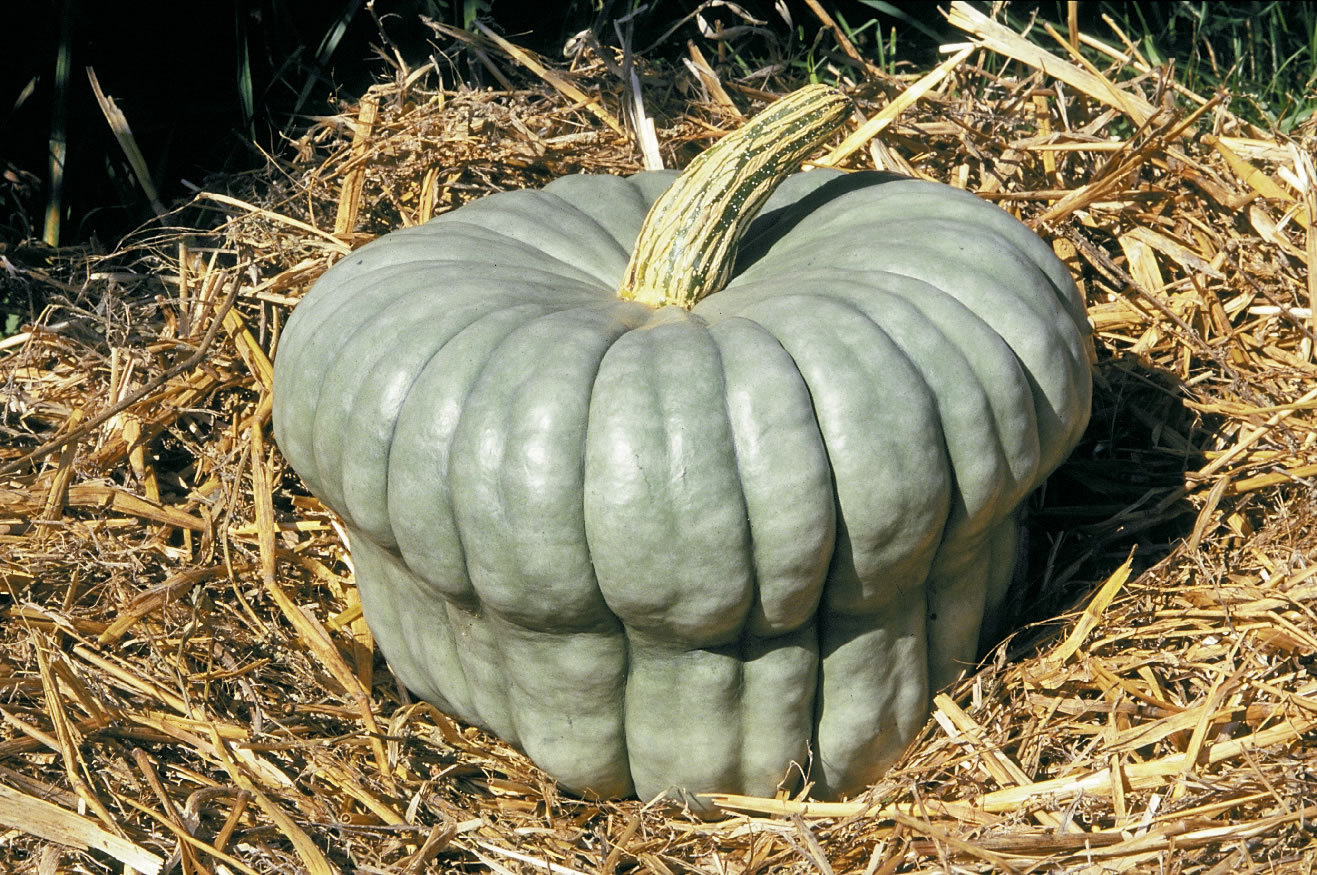
Suitable for cooking
The Queensland Blue, an Australian variety introduced to the U.S. in 1932, is another delicious variety. The blue-grey skin in varying shades is uneven on the surface with deep ribs and bright orange flesh. 10 to 20 lb.
It has a deep ribbing with a turban-buttercup shape. It is very similar to a Jarrahdale. When looked at from the side, I believe they affectionately look like Frankenstein's head. It has good baking quality and stores well.
They are long vines and the young fruit does not seem to like damp. I got this one because I let it grow out of the bed into the path where it got more air and sun. It's about 10-12 inches in diameter. The vines scarred around the vine borer and just kept growing. Harvest when it turns blue, then grey. Leave a bit of stem on. It has a dry flesh that is wonderful baked.
Varieties:
New Zealand Blue
An unusual heirloom with electrifying blue skin from New Zealand. Cut into this beautiful squash to reveal an intensely orange flesh. The flavor is incredible--sweet and nutty when roasted. Fruits average 6-8 pounds and will keep well over the winter. 110 days.
Beaudesert Blue
This is a very rare and old Australian Heirloom variety. It was bred in Queensland in 1910 as a cross between 3 local varieties. The fruit is round and flat with rind that is a smooth blue-green colour with at least 20 deep ribs. Inside, the yellow flesh is firm, moist and delicious. With maturity, the rind becomes quite hard, which means this would be a great long keeper. Our fruit weighed between 4kg and 5kg and were picked at around 100 days. The vines are large, but quite productive.
|
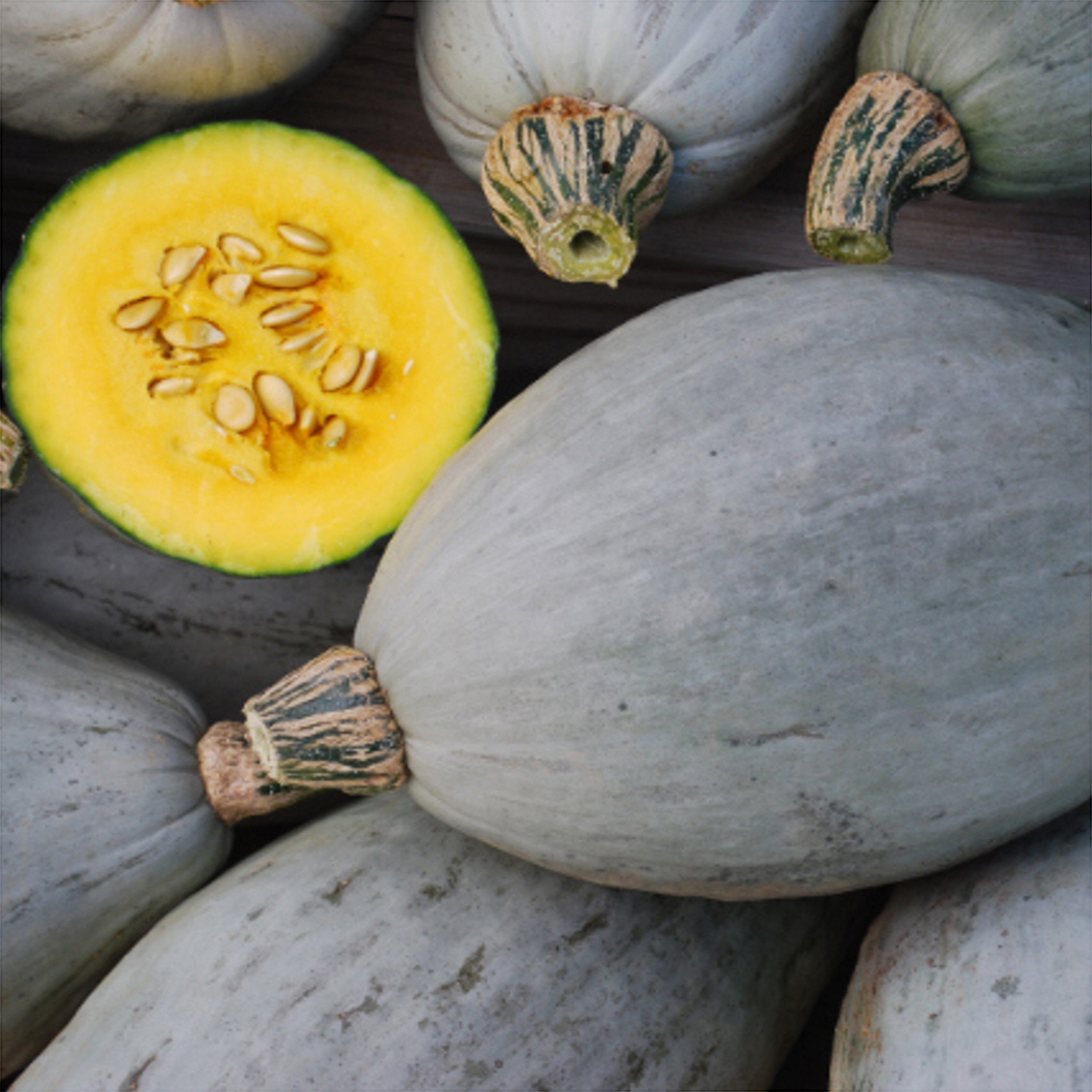
Also known as Pike’s Peak. Among the very best for flavor, this once-revered brown-seeded heirloom first surfaced in the Missouri River watershed in the 1830s and is similar to kindred varieties found among the Winnebago Indians.
It is a traditional Native American variety due to the brown color of its seeds. It was passed on by Mrs. Van Dinam, who had been cultivating it for nearly 50 years since 1840 in Missouri. She is probably from Mexico. This variety was introduced commercially by Hiram Sibley of Rochester, New York, in 1887.
Hiram has been growing it in Maine in recent years, selecting for trueness to type, taste and adaptability.
Vigorous 12–15' vines produce slate-blue obpyriform 1' long fruit weighing 6–8 lb, once described by Michael Pollan as “pinched in both ends and bulging at the waist.” Liberty, ME, gardener Jake Kennedy adds that these fetching fruits resemble baby seals hauled out on a ledge. Famous New England seedsman James J.H. Gregory called it “magnificent” and Goldman rates it “the best of the bananas,” a group she calls “top tier.” Ours was rich, moist, flavorful and sweet, though we sampled it in October, too soon. The quintessential storage squash, not coming into its own until January after its orange flesh has dried and sweetened. Hubbard type squash.
|

The fruits have a rounded and flattened shape and are brownish-gray with some salmon towards the peduncle. The texture is beautiful and the flavor is excellent. Each plant can carry from 4 to 6 fruits up to 3 kg each. Maturity: 90 days.
This variety is native to Brazil was discovered in the 1980's in Brazil by American seed collector Mary Schultz.
Stores well as long as the stem is allowed to dry off correctly.
Varieties:
Volskaya Grey
This new squash from the Volga region of Russia is a large (10 kg or so) mid-season blue-grey squash that gains a pink blush in storage.
This strain is maintained by Tom Hartley, who has produced a batch of really plump & vigorous seed.
Original squash found by Tom Hartley's mother in Russia. Does well in the UK.
Bylinka
Small sized grey for storing.
A superb example of open-pollinated breeding in the old Soviet Union. Bred to be dry-farmed by the Ukrainian Academy of Agricultural Sciences, the fruits are very thick-fleshed, and reach a workable 4-10 lbs. Attractive fruits are flattened, sometimes slightly segmented, of gray or light gray color; some having pale pink spots. Bylinka has documented disease resistance (anthracnose and powdery mildew). Our grower reports excellent production. Stores for a long time, up to March at 15 ° C. Very uniform with a reliable yield for an open pollinated variety of this type. 100 days.
Loche du Perou
Fruit: beige / brown, flat-round, sometimes somewhat oblong; Fruit size (DxH): 20 x 13 cm, the largest reached 35 cm in diameter; Flesh: dark orange, dry, sweet; Recommended use: roast / grill , oven , for steaming , salad / dip , deep frying. Storage time: ++++
Plant: climbing; Weight: 3.0 kg - 5.0 kg. Ripening time: 120 days
Mayo Blusher
The large, white to light green fruits are round to elongated in shape and blush pink when fully ripe. The apricot colored flesh has a wonderful sweet flavor and good firm texture. Good keepers. Very prolific variety for low desert, hot gardens. It was a staff favorite when grown at the early NS/S location on NY Drive in Tucson. It would even grow into the street.
|
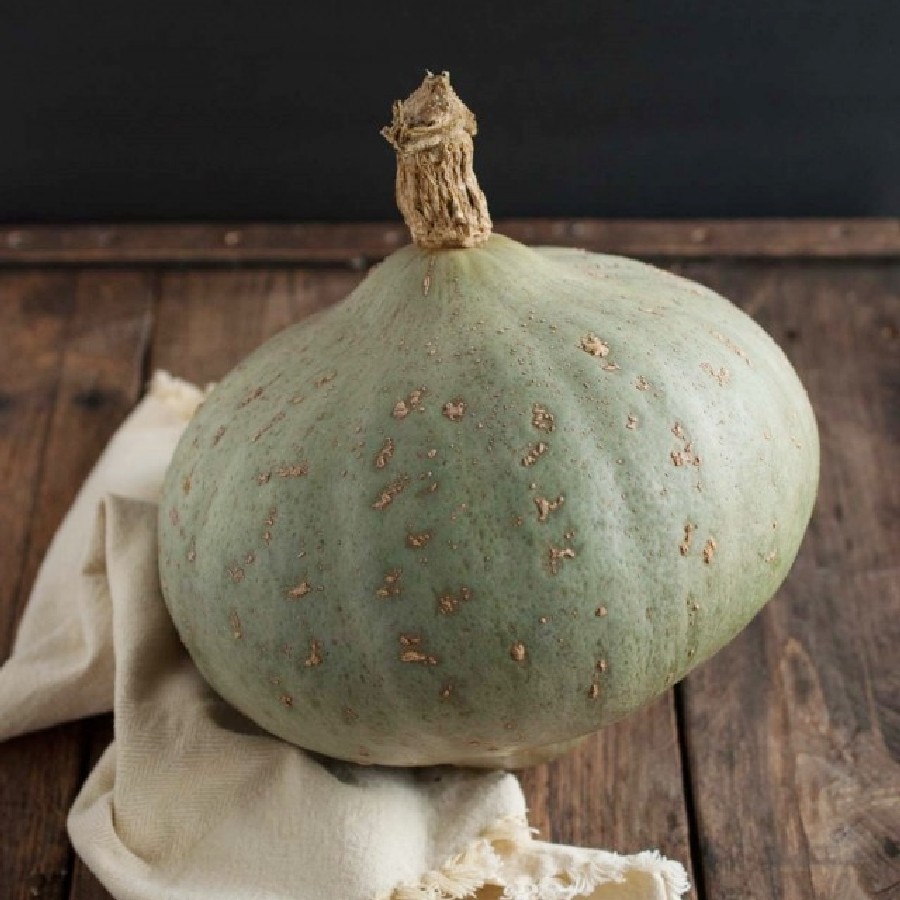
It has a long history in the Pacific Northwest, being introduced by the Gill Brothers seed company of Portland, OR nearly 100 years ago. When a plant variety is grown in a certain region for a length of time, it will adapt to the local ecosystem and be more productive than seeds from a national producer. It is also called "Oregon Sweet Meat". It was introduced in the collection of the Vavilov Institute in Russia in 1960.
Sweet Meat is an heirloom, hubbard type squash. It has slate blue/grey skin, with thick, yellow/gold flesh, that is sweet and dry. Flesh is finely textured. It is excellent for pies and soups, but is also very good in any winter squash recipe or just plain eating. These store very well and can even improve with storage. They can be pretty big, ranging from 7 to 15 pounds. Produces fruits that are large and flattened in shape.
How to grow Sweet Meat
Seven Trees Sweet Meat Gallery
Varieties:
Oregon Homestead Variety
Sweet Keeper
Very long plants, up to 8 meters long, producing rounded fruits and a little flattened from 5 to 7 kg. The thick epidermis is gray-green in color. The flesh of orange color is very soft. It has a high beta-carotene content. The fruits are particularly well preserved (until the following spring!). Growth: 95 to 105 days.
This old variety is native to the USA.
|
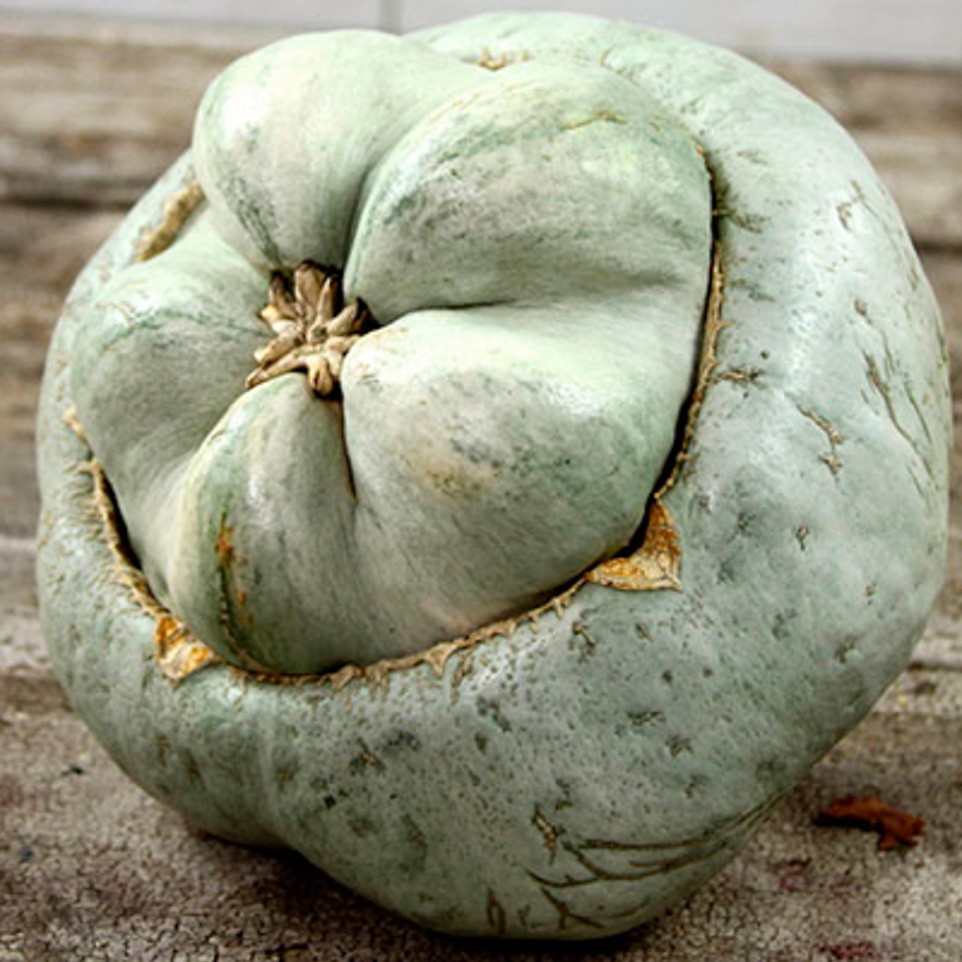
Shaped like a green Turks Turban squash, with a huge 'button' on the bottom, this ancient variety is from the native Ute people who lived Colorado from AD 1300 to 1881.
It is now sold by Baker Creek Seeds in the USA.
Seed Reviews:
Grows well in Wales UK
Varieties:
Whangaparoa Crown
1 to 3 kgs fruit.
An old variety from New Zealand.
Nanticoke Squash
This seed from Nate Kleinman and @experimentalfarmnetwork has many expressions, and those in this photo are the most beautiful we found! Silvery blue or pink with warts all over, and orange, sweet flesh. The Nanticoke Tribe (aka Kuskarawaoks, who speak Algonquian, the common language of the northeast) is of the Eastern Shore of Maryland and Delaware, a stones throw from where our Seed Keepers Collective was gathering just days ago.
- SeedKeepers.tumblr
"The Nanticoke squash are really starting to come in now! Aren't they just gorgeous? As we've frequently said, we're really excited to get lots of these growing all over the country next year - but especially by some of our Nanticoke neighbors in South Jersey and Delaware. As far as we have learned - including by asking the Nanticoke Lenni-Lenape chief Mark Gould and his associates, plus anyone who would talk to us at last year's pow-wow - the Nanticoke themselves have lost track of this squash. I got seeds from the Seed Savers Exchange "vault" in Iowa seven or eight years ago.
EFN Board member and our favorite seed guru Will Woys Weaver believes the grey/blue form with the vertical striping looks just like a squash he once had in his collection called Appoquinnimink, originally from a location in Delaware. Given the geographic proximity between Appoquinnimink and Nanticoke country, we assume the Appoquinnimink took a ride on the Nanticoke genome and occasionally still pops up. This year, only a couple plants are producing that form, but interestingly they both have hermaphrodite flowers (male-leaning and female-leaning, with normal males too), and one in particular is growing prolifically - producing six full-size fruits thus far, including the one that is our new profile picture. The plant producting the pointy-ended pink/blue fruit (for which I've been selecting the past few years) also has some hermaphrodite flowers, as does at least one of the plants Will and Owen Taylor are growing out at Kutztown University this year from seeds we shared with them for the Roughwood Collection (when I visited, I managed to pick a few "tomorrow flowers" from their plants, kept them in water overnight, and they opened beautifully the next morning, laden with pollen, so we crossed them with a couple female flowers in our fields to continue expanding the genetic diversity of our crop; those two fruits are developing nicely).
We just love the various forms, the sweet taste (reminiscent of melons), the bright orange color on the inside, and the ability to keep at room temperature for well over a year!"
Experimental Farm Network
It is one of only a few surviving Native American winter squashes from the Eastern woodlands.
|
|
A squash native to Argentina. It is a good squash for eating - it is very dense as its translated name "Leaden Squash"¯ signifies - and has beautiful scarring on a slate-gray background. Average weight is 10 lbs. 100 days
In addition to the wild population in Argentina that can be found under the name subspecies Cucurbita maxima subsp. orreana or as the Cucurbita andreana species. Zapallito meaning zucchini in Spanish.
Varieties:
Chilean Pumpkin
Turban-like squash from Chile with blue green skin. Sometimes warted.
Potiron d'Argentine
A variety from Argentina. Plant: vine;
Fruits: decorative, round, flattened, green with light spots; Size (DxL): 22-12 cm; Flesh: yellow-orange, thick, firm, finely grained, dry, good quality; Usage-Recommendation: Soup, Puree, Oven, Steam, Deep-Fry Storage time: +++ Weight: 1.5 kg - 3.0 kg Maturity: 110 days
|
|
|
 MBZ
MBZ
